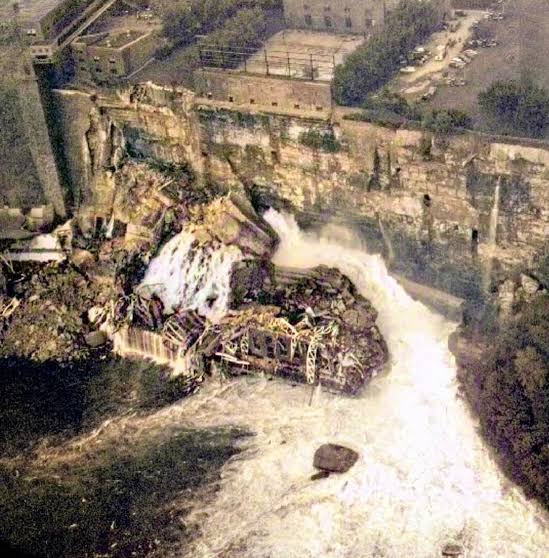Niagara Falls Catastrophe: Massive Section of Power Station Wall Collapses Without Warning
Niagara Falls Catastrophe: Massive Section of Power Station Wall Collapses Without Warning
A Devastating Disaster at One of America’s Largest Hydroelectric Stations
On June 7, 1954, the Schoellkopf Power Station, a major hydroelectric facility on the American side of Niagara Falls, suffered a catastrophic collapse. A massive section of the station’s wall unexpectedly gave way, sending thousands of tons of rock, concrete, and debris crashing down into the Niagara River. The disaster resulted in extensive damage, loss of life, and a major power crisis in the region.
A Structure Built for Power—But Doomed by Nature
The Schoellkopf Power Station, built in 1905, was once a symbol of technological progress and a crucial source of hydroelectric power for western New York. The facility was constructed along the gorge wall, using the immense power of the Niagara River to generate electricity. Over the years, the station underwent several expansions to meet the growing energy demands of the region.
However, despite its structural upgrades, the plant’s foundation had one major flaw: the soft limestone rock on which it was built. The relentless forces of water and erosion slowly weakened the walls of the facility over time. Experts later determined that the collapse was not entirely unexpected, as cracks had been observed in the weeks leading up to the disaster—but no immediate action had been taken.
The Moment of Collapse
On the afternoon of June 7, 1954, workers inside the station began to notice unusual cracking sounds and vibrations. Before they could fully react, a huge section of the station’s southern wall suddenly crumbled, triggering a chain reaction that sent large chunks of the structure plunging into the river below. The collapse was so forceful that it generated waves in the Niagara River, causing further damage to surrounding infrastructure.
Among the workers at the scene, one man, Richard Draper, tragically lost his life, while others barely managed to escape. Eyewitnesses reported seeing massive clouds of dust and debris rising from the gorge as sections of the building continued to crumble. Within minutes, a power station that had operated for nearly five decades was reduced to rubble.
Immediate Aftermath and Power Crisis
The collapse of the Schoellkopf Power Station wiped out over 320,000 kilowatts of hydroelectric power, plunging many parts of the region into a temporary energy crisis. Authorities scrambled to restore electricity while also launching investigations into the cause of the collapse.
The cleanup operation took months, with engineers struggling to remove debris from the gorge and salvage what little was left of the station. The disaster also accelerated plans for the construction of a new, safer power facility, which ultimately led to the development of the Robert Moses Niagara Power Plant in the 1960s.
Legacy of the Disaster
Today, the ruins of the Schoellkopf Power Station still remain at the base of the Niagara Gorge, serving as a haunting reminder of the tragic collapse. Visitors to Niagara Falls can see remnants of the old structure near the Niagara Gorge Discovery Center, where the site has been partially preserved as a historical landmark.
The 1954 collapse was a wake-up call for engineers and environmentalists, highlighting the risks of building massive structures near constantly eroding natural formations. It also underscored the unpredictable power of Niagara Falls, where nature often reclaims what humans build in its path.
While the disaster is now a part of history, its impact on hydroelectric power development in the region continues to be felt today. The lessons learned from this catastrophe have influenced modern engineering practices, ensuring that future projects are built with greater consideration for natural erosion and geological stability.






